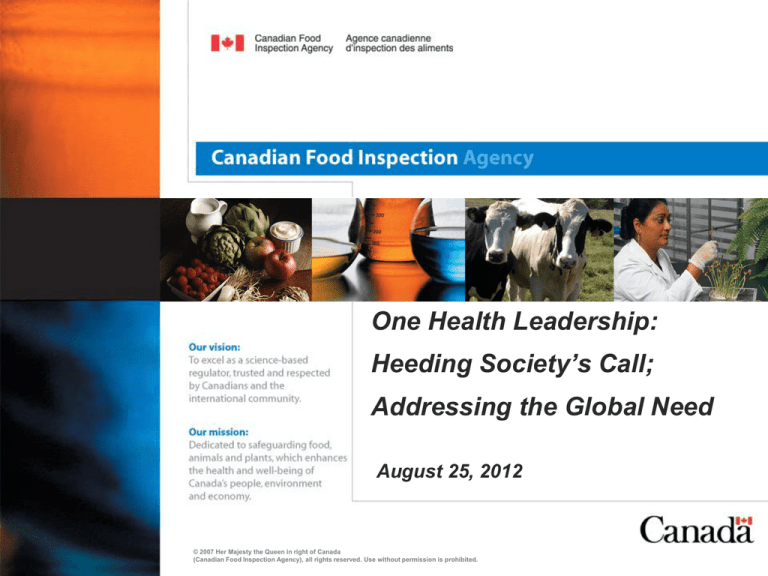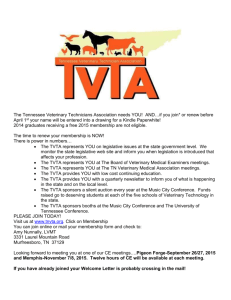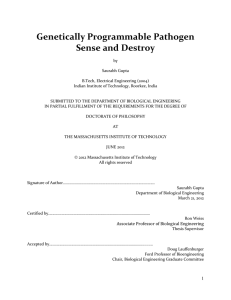
One Health Leadership:
Heeding Society’s Call;
Addressing the Global Need
August 25, 2012
© 2007 Her Majesty the Queen in right of Canada
(Canadian Food Inspection Agency), all rights reserved. Use without permission is prohibited.
Overview
• One Health is Not New
• So What has Changed? The Convergence Dilemma
• Scoping the Definition of One Health
• One Health Call to Action
• Animals as Sentinels
• Disease Control Has Consequences
• Changing International Standards
• The Leadership Path
• D.V.M.’s Are……..
2
One Health Is Not New
• From time immemorial……
• From hunting to herding to domestication…..
• First nations culture…….
• International bragging rights….
3
Bourgelat
Bourgelat
Claude
Bourgelat
1712-1779
Rudolph Virchow
(1821–1902
Between animal and
human medicine there
is
no dividing line –nor
should there be.”
19th century and the early 20th century there was
continued interest in linking human and veterinary
medicine based on the discoveries that there were
similar disease processes in both animals and
humans.
History of “One Health”
Sir William Osler (1849 - 1919)
•
Father of modern medicine
•
Taught at the Montreal Veterinary College and had responsibilities
at McGill University Medical School
•
Pioneered the concepts of comparative medicine and comparative pathology
and made important contributions to the standards of veterinary education
The term "one medicine" (forerunner
of the more current term, One
Health) was used by Dr. Schwabe
in his 1984 book, Veterinary
Medicine and Human Health, to
bring a renewed interest to the
synergy that can emerge when
health practitioners and scientists
collaborate. His insightful words,
"The critical needs of man include
the combating of diseases,
ensuring enough food, adequate
environmental quality, and a
society in which humane values
prevail," are even more
compelling today.
Convergence Model : The Perfect Biological Storm
Genetic and
Biological
Factors
Physical and
Environmental
Factors
Animals
EID
Humans
Wildlife
Social, Political,
and Economic
Factors
Ecological
Factors
Dilemma Drivers
Genetic and biological factors
•
•
•
Microbial adaptation and change
Susceptibility to infection
Loss of biodiversity
Physical environmental factors
•
•
Climate and weather
Economic development and land
use
Ecological factors
•
•
•
Changing ecosystems
Human demographics and behavior
Animal production systems
Social, political, and economic factors
•
•
•
•
Globalization of people, commerce
and pathogens
Poverty and social inequity
Food security
Intent to harm
Convergence Model : The Perfect Biological Storm
Genetic and
Biological
Factors
Physical and
Environmental
Factors
Animals
Food
Security
Humans
Wildlife
Social, Political,
and Economic
Factors
Ecological
Factors
What is One Health?
•One Health is about managing
health threats at the interface
between eco-system health,
animal health and human
health
Ecosystems
•It recognizes that the health of
people, animals and the
ecosystem of which we are a
part, are interconnected.
Animals
Humans
Scoping the Definition of One Health
Health is more than the absence of disease
• A dynamic state of complete physical, mental, spiritual and social well-
being and not merely the absence of disease or infirmity
The health impacts resulting from an animal disease
outbreak can be physical, emotional and
psychological
Social, cultural, economic, political and environmental
consequences can arise from animal disease
occurrences
• Loss of identity or social status, community disruption, family breakdown,
loss of species of religious and cultural significance, loss of primary source
of nutrition, loss of biodiversity, loss of livelihood, loss of public confidence
Scoping the Definition of One Health
• One health is problem solving with an emphasis on
determining the cause of the cause (of the cause).
• One health is being more cost effective by moving from paying
for consequences to investing in prevention and mitigation.
• One health is preventive medicine for multiple species in
parallel.
• One health is much more than the control of zoonoses. It
includes food security and food safety, sustainable production
systems, protection of biodiversity and genetics and the well
being derived from the human:animal bond.
• One Health is the “Nature of Things” for real
One Health 101 As An Acronym
• Our
• Necessity
• Entails
• Humans
• Eco-systems and
• Animals
• Living
• Together
• Harmoniously
• Brian Evans, Global One Health Conference, Melbourne,
Australia, January 2010
Challenges: Economic Impact of Emerging
Infectious Disease
hunger is the world’s No. 1 public health
threat—
killing more people than AIDS, malaria and
tuberculosis combined.”
—James T. Morris, Executive Director,
U.N. World Food Programme
March 15, 2007
Photos by Astronaut Sunita Williams
Two families
Germany: The Melander family
of
Bargteheide
Food expenditure for one week:
375.39 Euros or $500.07
Chad: The Aboubakar family
of Breidjing Camp
Food expenditure for one week:
685 CFA Francs or $1.23
http://www.humanespot.org/node/2885
Clockwise from top left: Algeria, Egypt, Tunisia and Yemen - FAO, IMF
anticipate more civil unrest and protests because of soaring food prices
One Health Call To Action
• One Health is why we should be paying attention to
white nose syndrome in bats
• Estimated death of 7 million bats in 20 states and four provinces
• Capable of consuming 21 metric tons of insects per night
• Many of the insects are known vectors of transmissible diseases
• One Health is why we should be paying attention to
sick oceans
• 80 per cent of earths species reside in the oceans
• Fastest growing source of animal protein to address global food
security challenge is derived from aquaculture
• Carbon sequestration increasing acidity
• Warming of the planet
• Disruption of the food chain
Animals as Sentinels
• The full potential of linking animal and human
health information to provide early warning of
shared disease risks from environmental hazards
has not been realised
• The One Health concept holds promise for
improved sentinel event coordination in order to
detect and reduce environmental health threats
shared between humans and animals
Animals as Sentinels (toxic and infectious
disease)
• Mercury poisoning in cats (dancing cat disease)
• Cats eating fish from river containing mercury lead to testing of
humans eating same fish
• High levels of mercury exposure revealed
• Lead poisoning diagnosed in pets exposed to paint
chips leading to positive findings in children
• Caged canaries in coal mines for early warning of
toxic gas exposure
• Chickens serving as sentinels for West Nile Virus
exposure risk for humans
Zoonoses are a two way street
Stamping out policy
photo: Tom Brownlie RVC (Final year) 2001
Joe Brownli e
Royal V et eri nary College
.
© A. Michaud, 2003
World organisation for animal health
12 rue de prony
75017 paris, france
Tel: 33 (0)1 44 15 18 88 – Fax: 33 (0)1 42 67 09 87
Email: oie@oie.int
http://www.oie.int
The Evolution of International Standards
• Changes in disease reporting obligations
• Elimination of historic list A and list B
• Move to report:
• First occurrence of a listed disease
• Reoccurrence of a listed disease following declaration of
•
•
•
•
eradication
First occurrence of a new strain of a pathogen
Sudden or unexpected increase in the distribution,
incidence, morbidity or mortality of an indigenous disease
An emerging disease with significant morbidity, mortality or
zoonotic potential
Evidence of change in the epidemiology of a listed disease
such as host species or pathogenicity
The Evolution of International Standards
• Move from emphasis on country freedom status to
regionalization and compartmentalization
• Increased focus on commodity risk rather than
disease free status
• Emphasis on reward for investment in surveillance,
reporting and biosecurity measures
• All serve to increase the timeliness and
transparency of disease reporting
• Complimented by IHR and INFOSAN
The Leadership Path
•
Congratulations are in order
•
Believe that leadership potential has been
recognized in each of you
•
Leadership means influencing behaviours
•
Leadership means facilitating change in
response to new imperatives
•
Leadership means empowering and engaging
others
The Leadership Path
•
Leadership means asking the right questions
•
Leadership means acting with integrity
•
Leadership recognizes evidence and values as
important elements in decision making
•
Leadership comes in different styles
•
Support next generation of students as they
are the primary drivers behind innovation and
change
•
No generation understands interconnectivity better
D.V.M.’s Are………
Doctors of Veterinary Medicine (DVMs) and as a
result…
Doctors of Very Many Species (DVMs) and as a
result...
Doctors of Very Many Situations (DVMs) and as a
result…
Determiners of Very Many Scenarios (DVMs)
© 2007 Her Majesty the Queen in right of Canada
(Canadian Food Inspection Agency), all rights reserved. Use without permission is prohibited.
38








